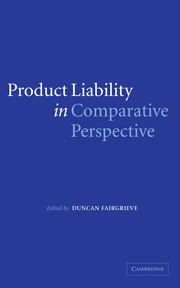Book contents
- Frontmatter
- Contents
- List of figures
- Foreword by Sir Michael Burton
- List of contributors
- Preface
- 1 Introduction
- PART I Country reports
- 2 The use of comparative law in A & Others v National Blood Authority
- 3 Spanish product liability today – adapting to the ‘new’ rules
- 4 Interaction between the European Directive on Product Liability and the former liability regime in Italy
- 5 L'Exception française? The French law of product liability
- 6 German product liability law: between European Directives, American Restatements and common sense
- 7 Dutch case law on the EU Product Liability Directive
- 8 Defect in English law – lessons for the harmonisation of European product liability
- PART II European influences
- PART III Comparing systems
- Appendix
- Index
4 - Interaction between the European Directive on Product Liability and the former liability regime in Italy
from PART I - Country reports
Published online by Cambridge University Press: 28 July 2009
- Frontmatter
- Contents
- List of figures
- Foreword by Sir Michael Burton
- List of contributors
- Preface
- 1 Introduction
- PART I Country reports
- 2 The use of comparative law in A & Others v National Blood Authority
- 3 Spanish product liability today – adapting to the ‘new’ rules
- 4 Interaction between the European Directive on Product Liability and the former liability regime in Italy
- 5 L'Exception française? The French law of product liability
- 6 German product liability law: between European Directives, American Restatements and common sense
- 7 Dutch case law on the EU Product Liability Directive
- 8 Defect in English law – lessons for the harmonisation of European product liability
- PART II European influences
- PART III Comparing systems
- Appendix
- Index
Summary
Introduction
Fifteen years after the implementation of the European Directive on product liability no more than ten cases have been decided by Italian courts. Trying to explain the EC Directive's impact on the Italian legal system, I will first describe the former liability regime engineered by the courts and by the scholars on the matter: usually, when a new social problem arises requiring a legal solution in a civil law system, the courts intervene before the legislator. Therefore, since the EC Directive has been enforced, it has started to interact with the solution previously adopted by the courts. I will then examine the application of the new law, pointing out in particular how the open-ended definition of ‘defect’ is interpreted and applied. The applications are not exempt from incoherence due to the ambiguous nature of product liability law, constantly shifting between tort law and contract liability. After comparing the former and the latter regime, we find that the EC Directive does not give any further advantage to consumers; on the contrary it provides several limitations to their right of claim. This makes other regimes more attractive. In particular, the EC Directive missed the opportunity to face the procedural problems arising from a mass tort case in order to improve access to justice. Consequently, whenever the consumer chooses to sue someone other than the manufacturer under a concurrent regime, or chooses not to sue any one, the product liability law fails to achieve its functions.
- Type
- Chapter
- Information
- Product Liability in Comparative Perspective , pp. 67 - 83Publisher: Cambridge University PressPrint publication year: 2005



